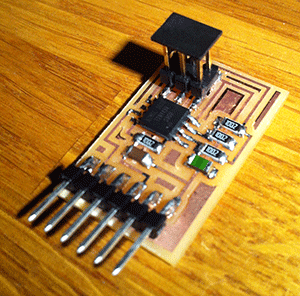 |
Fab Academy 2013 |
Input devices:This weeks assignment is to make an input device. My computer unfortunately gave up the ghost just before this class, so I had very little time to actually redesign a board. Instead I opted to just make one of Neil's example boards. I decided to make the Hello.Reflect board, so I downloaded the .PNG files and loaded them into the Fab Modules, and milled them out on the Modela. As I was soldering the parts on to the board, something wasn't right. It turned out that I actually milled out internals for the hello.temp board; I guess I got my files mixed up. I decided to go with it and just make that board, but I ended up also milling out the correct hello.reflect board. After milling and soldering the boards, I jumped into Terminal to load the boards up with the C code provided. I used the FTDI Programming tutorial provided in Embedded Programming to run through the commands. I got an error when I tried to flash the fuses, as I didn't realise that there weren't any external crystals and I could skip that step.
 
Programming the boards seemed to go off without a hitch, so it was time to see if they actually worked. I ran the provided python files for the Hello.Reflect board and pointed it to the correct serial port (ttyUSB1 in this case). Advised by our guru, I hooked up an oscillator to see how the data throughput was. It looked like there was very little coming in through the sensor, so it didn't really seem to register the red LED I had soldered next to it.
I found the data sheet for the OP580 (the light sensor) to figure out if it was compatible with the red LED. After checking over the board I noticed that one of the legs on the ATtiny45 didn't seem to be properly connected to the conductive pad. I resoldered it and connected it again, loading up the Python code. Finally, I had a working Hello.Reflect!
Now to recreate that success with the Hello.Temp board.
I used the same steps to get the code onto the board, and then ran the python file. A window with a bar popped up that immediately jumped up to 29.82 and stayed there. That didn't seem correct, so I hooked it up to an oscillator. The oscillator showed that there was practically no throughput on the temperature sensor. There should be at least 2.5 Volts, so there might be something shorting somewhere. |